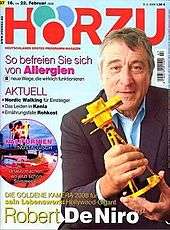Hörzu
Hörzu (German: [ˌhøːɐ̯ˈtsuː]) is a German weekly television listings magazine published in Hamburg.
 Hörzu sample cover | |
| Editor | Christian Hellmann |
|---|---|
| Categories | TV guide |
| Frequency | Weekly |
| Circulation | 1,038,901 (Q2 2016) |
| First issue | 1946 |
| Company | Funke Mediengruppe |
| Country | Germany |
| Based in | Hamburg |
| Language | German |
| Website | www |
History and profile
Hörzu first appeared in 1946[1][2] and was published by Axel Springer[3] as the first radio program magazine to be produced in what was then the British zone of occupation. Over the years Hörzu has shifted the emphasis of its coverage from radio to television programs. The magazine is based in Hamburg.[1]
The first edition of the magazine appeared on 11 December 1946 as HÖR ZU! Die Rundfunkzeitung ("LISTEN! The radio newspaper") as it was originally entitled. There were three editions in the first year of publication, 48 in 1947, and since then the magazine has appeared 52 or 53 times annually.
The circulation of the magazine increased rapidly. 1949 saw the first appearance of Mecki, Hörzu's cartoon hedgehog mascot. In the 1960s Hörzu produced and released records as a subsidiary of Electrola, Cologne. Since 1965, the Hörzu has awarded the annual Golden Camera television prize.
In early 2010, the bimonthly magazine Hörzu Wissen ("Hörzu Knowledge") was launched, which covers science, history, health, and technology topics.[4] The magazine launch was considered a major success by Springer AG, with the premiere issue selling 130,000 copies.[5]
The magazine was sold to Funke Mediengruppe in 2013.[6]
Circulation
During the third quarter of 1992 the circulation of Hörzu was 3,103,000 copies.[7] The magazine had a circulation of 2,426,000 copies during the third quarter of 1995 and 2,367,000 copies during the third quarter of 1996.[8] In 1999 the circulation of the magazine was 2,226,700 copies.[9]
It was one of fifty best-selling television magazines worldwide with a circulation of 2,077,000 copies in 2001.[10] The average circulation of Hörzu was 1,678,000 copies in 2003.[11] In the fourth quarter of 2006 its circulation was 1,585,100 copies.[11] The magazine had a circulation of 1,431,490 copies in 2010.[12] In 2012 the circulation of the magazine was 1,275,600 copies.[13] During the second quarter of 2016 it was 1,038,901 copies.[14]
Editors-in-chief of Hörzu
- Eduard Rhein (1946)
- Hans Bluhm (1965)
- Peter Bachér (1974)
- Felix Schmidt (1985)
- Helmut Reinke (1987)
- Klaus Stampfuss (1989)
- Andreas Petzold (1997)
- Michael Lohmann (1999)
- Jörg Walberer (2001)
- Thomas Garms (2003)
- Christian Hellmann (2009)
References
- Western Europe 2003. Psychology Press. 30 November 2002. p. 294. ISBN 978-1-85743-152-0. Retrieved 28 February 2016.
- Tristam Carrington-Windo; Katrin Kohl (11 April 2013). Dictionary of Contemporary Germany. Routledge. p. 214. ISBN 978-1-136-59530-1. Retrieved 28 March 2015.
- Anthony Weymouth; Bernard Lamizet (3 June 2014). Markets and Myths: Forces For Change In the European Media. Taylor & Francis. p. 206. ISBN 978-1-317-88969-4. Retrieved 12 April 2015.
- Hörzu
- Top story article Archived 21 August 2010 at the Wayback Machine Meedia
- Stefan Schultz; et al. (26 July 2013). "Sell-Off: Newspaper Giant Turns Back on Journalism". Der Spiegel. Retrieved 16 December 2014.
- Georg Hellack (1992). "Press, Radio and Television in the Federal Republic of Germany" (Report). Inter Nationes. Retrieved 4 April 2015.
- Alasdair Reid (6 December 2006). "Fortnightly TV titles prove threat to German weekly listings magazines". Campaign. Retrieved 28 March 2015.
- Ingomar Kloss; M. Abe (1 January 2001). Advertising Worldwide: Advertising Conditions in Selected Countries. Springer Science & Business Media. p. 130. ISBN 978-3-540-67713-0. Retrieved 29 March 2015.
- "Top 50 TV Guides worldwide (by circulation)" (PDF). Magazines. Archived from the original (PDF) on 2 April 2015. Retrieved 28 March 2015.
- "European Publishing Monitor" (PDF). Turku School of Economics (Media Group). March 2007. Archived from the original (Report) on 10 October 2017. Retrieved 27 March 2015.
- "World Magazine Trends 2010/2011" (PDF). FIPP. Archived from the original (PDF) on 2 April 2015. Retrieved 4 April 2015.
- "Annual Report 2012" (PDF). Axel Springer AG. Archived from the original (PDF) on 5 March 2016. Retrieved 30 March 2015.
- "Advertising rates Magazines 2016". Media Impact. Archived from the original on 31 January 2016. Retrieved 18 September 2016.